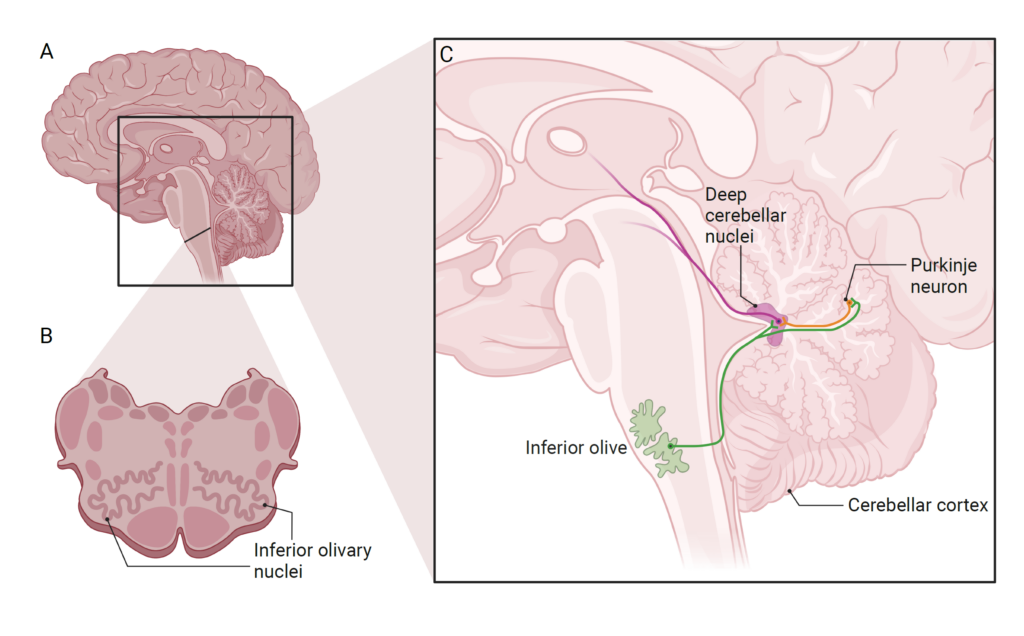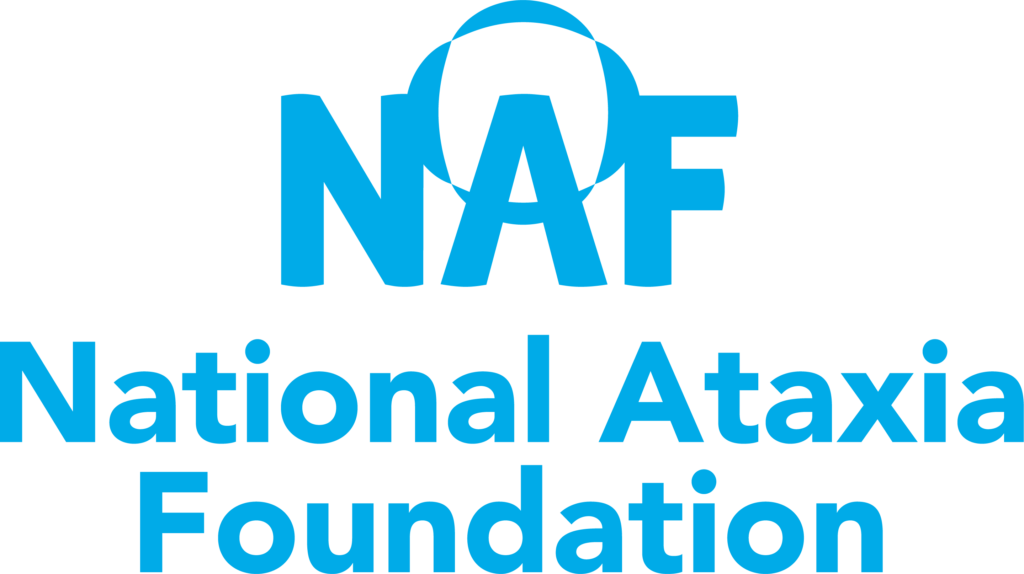
The inferior olive is a beautifully squiggly structure found in the brainstem. The brainstem connects the spinal cord to the brain and contains three major regions: the midbrain, pons, and medulla. Within the medulla, there is an inferior olivary nucleus, or inferior olive, on each side. These inferior olives are incredibly important for communication between our brain and our body.
The inferior olives are important in ataxia because they interact intimately with the cerebellum to help our bodies with balance and voluntary movements. The inferior olives give and receive motor and spatial information. Thus, issues arise when the connections between the inferior olives and the cerebellum are interrupted. This can be due to things like injury to the brainstem or, as is the case in many ataxias, genetic mutations. It is not surprising then that the inferior olives have been shown to have abnormalities in ataxias.

A) Sagittal section of human brain: the line indicates the location of the transverse section of the brainstem shown in B and the box indicates the region shown in C. B) Cross section of the medulla oblongata at the line indicated in A showing the inferior olivary nuclei. C) Sagittal section of the brainstem and cerebellum showing the spino-olivary tract (green). Imaged created by Dr. Hannah Shorrock with Biorender.com.
The inferior olives receive different types of information, both motor and sensory, from many areas of the central nervous system. These areas include the motor cortex, which is involved in planning and executing motion, brainstem nuclei (clusters of cells in the brainstem), the spinal cord, and the cerebellum. The inferior olives then combine this information into a new message which goes back to the cerebellum.
There are many different routes, or tracts of brain cells, throughout the central nervous system which communicate specific information in our bodies. The inferior olive is involved in a tract that is important for ataxias: the spino-olivary tract.
In the spino-olivary tract, the spinal cord receives information from the body about where it is in space. This is called proprioception, also known as kinesthesia. The peripheral nervous system sends the spinal cord proprioceptive information, and the spinal cord sends that information to the inferior olives.
The spino-olivary tract gets a little tricky because the neurons going from the inferior olives to the cerebellum cross to enter the opposite (or contralateral) side of the cerebellum. This means that information from the inferior olive on the left side crosses over to enter the right side of the cerebellum. These neurons, also known as climbing fibers, have two major destinations in the cerebellum.
The first major destination of the spino-olivary tract is the deep cerebellar nuclei which are clusters of cells in the cerebellum that serve many functions. There are four deep cerebellar nuclei (DCN) which are involved in balance, posture, motor learning, and voluntary movement. The inferior olivary nuclei stimulate the DCN which help with neural sharpening: crafting the perfect response. Think of Goldilocks and the Three Bears. Goldilocks went to the bears’ house and ate their porridge. Papa Bear’s porridge was too cold, baby bear’s porridge was too hot, and Mama Bear’s porridge was just right. The DCN make sure the ‘porridge’ is always just right. In the cerebellum this translates to the DCN making sure we don’t over- or undershoot our movements.
The second destination of the climbing fibers is the Purkinje cell layer of the cerebellum. Purkinje cells are large neurons and communicate far and wide. They are one of the main sites of degeneration and a primary driver of symptoms in ataxia. Climbing fibers from the inferior olives stimulate Purkinje cells which in turn inhibit the DCN. Sounds silly, right? This is actually really important for the “Goldilocks” effect of the DCN: not too hot, not too cold, but just right! In ataxia, because the connections between the inferior olives and the cerebellum can be interrupted, this Goldilocks effect may be disrupted thereby influencing how a person moves.
If you would like to learn more about Inferior Olive, take a look at this resource by Neuroscientifically Challenged.
Snapshot Written by: Tala Ortiz
Edited by:Dr. Hannah Shorrock
Read Other SCAsource Snapshot Articles

Snapshot: What is Spasticity?
Spasticity is a condition where muscles involuntarily stiffen, impeding normal smooth movements. Spasticity can present in varying severities with varying impacts on daily life. For example, minor spasticity resulting in Read More…


Snapshot: What is Articulation?
Articulation refers to the ability to produce speech sounds using the tongue, lips, jaw, and the roof of your mouth. All of these organs are also known as articulators. The Read More…


Snapshot: What is Resonance?
In speech-language pathology, the term resonance refers to nasality in speech. In other words, how nasal a person’s speech sounds. When someone is congested, they likely sound hyponasal, or not Read More…









